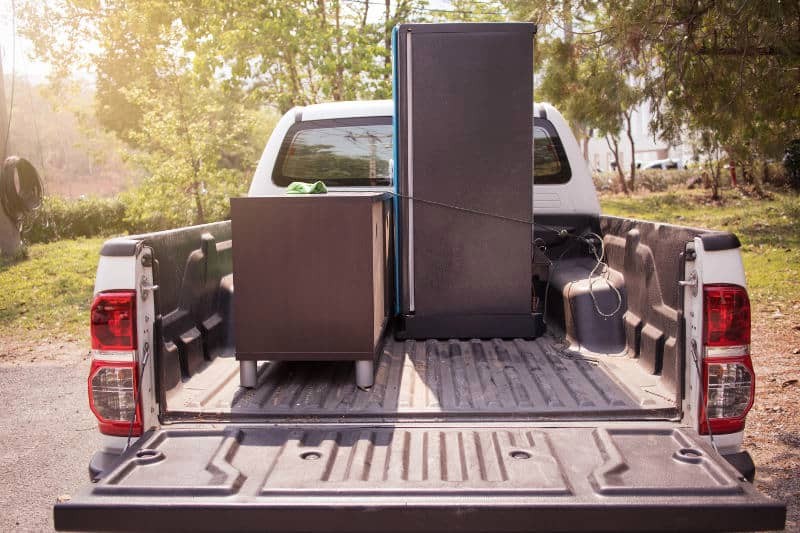When it comes to moving a refrigerator, one common question arises: can you safely transport it laying down? In this blog post, we will explore this topic and provide essential information to help you make an informed decision.
Safely transporting a refrigerator is crucial to avoid potential damage, such as internal leaks, compressor issues, or structural damage. Ensuring its safe transport will help you maintain the appliance’s functionality and longevity.
Many people have concerns about transporting a refrigerator laying down, fearing that it may cause irreparable damage or affect its cooling system. This post addresses these concerns and debunk any misconceptions to provide clarity on the matter.
Factors to Consider
Size and Weight of The Refrigerator
When deciding whether you can safely transport your refrigerator laying down, one crucial factor to consider is its size and weight. Larger and heavier refrigerators can be more challenging to transport without causing damage. It’s important to check the specifications of your particular refrigerator model to determine if laying it down during transportation is acceptable. Some larger refrigerators may be explicitly designed to be transported in an upright position only. However, smaller and lighter refrigerators may have more flexibility in their transportation methods.
Manufacturer’s Guidelines and Recommendations
Before transporting your refrigerator, it is crucial to refer to the manufacturer’s guidelines and recommendations. Manufacturers typically provide specific instructions for safe transportation, including whether the refrigerator can be transported laying down. These guidelines are designed to ensure the integrity of the appliance and prevent any potential damage during transportation. Pay close attention to any warnings or precautions mentioned in the user manual or on the manufacturer’s website. Following these guidelines will help you make an informed decision about the proper transportation method for your refrigerator, whether it is upright or laying down.
Transportation Method
When it comes to transporting your refrigerator, the choice of transportation method plays a crucial role in ensuring its safety. If you opt for using a personal vehicle, there are a few things to keep in mind. Make sure the refrigerator fits securely in the vehicle, allowing enough space for proper cushioning and preventing any movement during transportation. Consider the size and weight of your refrigerator to ensure it can be safely loaded and unloaded. On the other hand, if you decide to hire professional movers, they have the expertise and equipment to handle the transportation process smoothly. They are experienced in maneuvering large appliances, reducing the risk of damage.
Distance and Road Conditions
When it comes to transporting your refrigerator, the choice of transportation method plays a crucial role in ensuring its safety. If you opt for using a personal vehicle, there are a few things to keep in mind. Make sure the refrigerator fits securely in the vehicle, allowing enough space for proper cushioning and preventing any movement during transportation. Consider the size and weight of your refrigerator to ensure it can be safely loaded and unloaded. On the other hand, if you decide to hire professional movers, they have the expertise and equipment to handle the transportation process smoothly. They are experienced in maneuvering large appliances, reducing the risk of damage.
Proper Preparations
Cleaning and Defrosting The Refrigerator
Before transporting your refrigerator, it is crucial to clean and defrost it properly. Remove all the perishable items and discard any expired or spoiled food. Thoroughly clean the interior with a mild detergent and water solution, ensuring there are no spills or residue left behind. Additionally, defrost the freezer compartment in advance to prevent water leakage during transportation.
Protecting the Exterior From Scratches and Dents
Before transporting your refrigerator, it’s crucial to safeguard its exterior to prevent any damage. Start by covering the refrigerator with a protective blanket or moving pads. This will help cushion it and provide a barrier against scratches and dents during the transportation process. Additionally, you can use painter’s tape or straps to secure the protective covering in place, ensuring it doesn’t come loose while on the move.
Securing Loose Components And Shelves
To prevent damage to your refrigerator during transport, secure any loose components and remove or secure shelves and drawers. Remove detachable parts such as doors, handles, and glass shelves, if possible, and pack them separately in bubble wrap or blankets. If some components cannot be removed, secure them with tape or straps to minimize movement.
Disconnecting and safely storing any detachable parts (e.g., doors, handles)
To avoid potential damage or accidents during transportation, it’s essential to disconnect and securely store any detachable parts of the refrigerator, such as doors, handles, and shelves. Check the manufacturer’s instructions or user manual for guidance on how to remove these parts safely. Once removed, carefully pack them in a separate box or wrap them in bubble wrap. Label the box or wrap clearly to ensure easy reattachment after transportation.
Safe Transportation Methods
Upright Transportation: Advantages and Precautions
This method offers several advantages. Firstly, keeping the refrigerator in an upright position ensures that the compressor and other internal components remain in their proper alignment, reducing the risk of damage. Secondly, it allows for better weight distribution, making it easier to load and unload the refrigerator without straining yourself. However, there are still precautions to consider. Make sure to secure the refrigerator inside the vehicle using straps or bungee cords to prevent it from shifting during transit. Avoid tilting the refrigerator excessively or subjecting it to sudden jolts. It’s also essential to take note of the refrigerator’s dimensions to ensure it fits in the vehicle and passes through doorways without difficulty.
Laying Down Transportation: Advantages and Precautions
Transporting a refrigerator by laying it down can offer some benefits. It provides stability during transport and makes it easier to navigate tight spaces. However, it’s crucial to check the manufacturer’s guidelines first, as some models may not be suitable for this method due to potential damage to the cooling system. If you choose to transport it horizontally, ensure it remains level to prevent oil leakage. Protect fragile components, secure doors, and remove loose parts. Be careful during loading and unloading to avoid jolts. By considering these precautions, transporting your refrigerator laying down can be a viable option when done correctly.
Tips for Loading and Unloading the Refrigerator
Before loading, make sure the refrigerator is empty, defrosted, and clean. Remove any detachable parts, such as doors or shelves, and securely store them. To protect the exterior from scratches and dents, consider using furniture blankets or bubble wrap. When loading the refrigerator onto a vehicle, ensure that it is positioned securely and will not shift during transport. During unloading, take extra care to avoid tipping or dropping the refrigerator. Ensure a clear path and use a dolly or assistance if needed. By following these tips, you can minimize the risk of damage during the loading and unloading process, regardless of whether the refrigerator is transported upright or laying down.
In this post, we address the common concern of transporting a refrigerator in a horizontal position. We emphasize the importance of safely transporting the appliance to avoid damage and ensure its functionality and longevity. Factors to consider include the size and weight of the refrigerator, manufacturer’s guidelines and recommendations, transportation method (personal vehicle or professional movers), and distance and road conditions. Proper preparations, such as cleaning and defrosting the refrigerator, securing loose components and shelves, protecting the exterior from scratches and dents, and disconnecting detachable parts, are essential. We discuss the advantages and precautions of both upright and lying down transportation methods. Finally, we provide useful tips for loading and unloading the refrigerator to minimize the risk of damage during the transportation process.
Publisher’s Details:
Triple 7 Movers
4480 Calimesa St, Las Vegas, NV 89115
(866) 650-7698
triple7movers.com
info@triple7movers.com
When it comes to providing exceptional local moving services in Paradise, NV, look no further than Triple 7 Movers. We offer the best services in the area, ensuring a hassle-free and efficient move. While planning a move, it’s crucial to ensure the safety of your appliances. If you’re uncertain about how to check if your appliances are safe for relocation, read this blog post on Triple 7 Movers’ Website.

